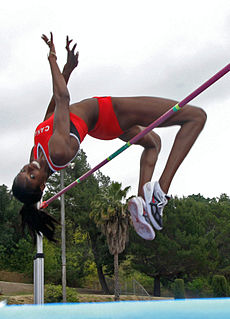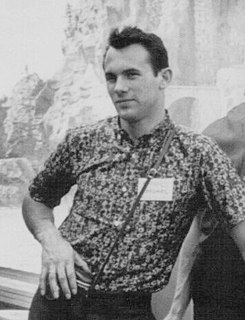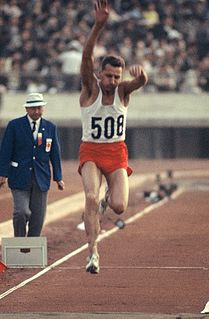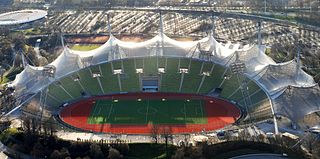
The high jump is a track and field event in which competitors must jump unaided over a horizontal bar placed at measured heights without dislodging it. In its modern, most-practiced format, a bar is placed between two standards with a crash mat for landing. Since ancient times, competitors have introduced increasingly effective techniques to arrive at the current form, and the current universally preferred method is the Fosbury Flop, in which athletes run towards the bar and leap head first with their back to the bar.

Valeriy Nikolayevich Brumel was a Soviet high jumper. The 1964 Olympic champion and multiple world record holder, he is regarded as one of the greatest athletes ever to compete in the high jump. His international career was ended by a motorcycle accident in 1965.

The men's long jump was one of four men's jumping events on the Athletics at the 1964 Summer Olympics program in Tokyo. It was held on 18 October 1964. 37 athletes from 23 nations entered, with 5 not starting in the qualification round. The maximum number of athletes per nation had been set at 3 since the 1930 Olympic Congress. The event was won by Lynn Davies of Great Britain, breaking a string of eight straight American victories. It was Great Britain's first gold medal in the men's long jump, and first medal since 1900. It was only the second time the United States had not won the event, with Sweden's William Petersson in 1920 the only non-American to win before Davies. Ralph Boston of the United States and Igor Ter-Ovanesyan of the Soviet Union became the third and fourth men to win a second medal in the long jump.

The men's triple jump was one of four men's jumping events on the Athletics at the 1964 Summer Olympics program in Tokyo. It was held on 16 October 1964. 36 athletes from 23 nations entered, with 2 not starting in the qualification round. The maximum number of athletes per nation had been set at 3 since the 1930 Olympic Congress. The event was won by Józef Szmidt of Poland, the third man to repeat as Olympic champion in the triple jump. Just as in 1960, the Soviet Union took silver and bronze behind Szmidt.

The men's high jump was one of four men's jumping events on the Athletics at the 1964 Summer Olympics program in Tokyo. Qualification was held on October 20, 1964, with the final on October 21. 29 athletes from 20 nations entered, with 1 not starting in the qualification round. The maximum number of athletes per nation had been set at 3 since the 1930 Olympic Congress. The event was won by Valeriy Brumel of the Soviet Union, the nation's second consecutive victory in the men's high jump. Brumel, who had earned silver in 1960, and American John Thomas, who had previously taken bronze in 1960 and now won silver, became the first two men to win multiple medals in the Olympic high jump. John Rambo, also of the United States, won bronze to complete the podium.
The men's high jump competition at the 1988 Summer Olympics in Seoul, South Korea had an entry list of 27 competitors from 18 nations, with two qualifying groups before the final (16) took place on Sunday September 25, 1988. The maximum number of athletes per nation had been set at 3 since the 1930 Olympic Congress. There were two bronze medals awarded. The event was won by Hennadiy Avdyeyenko of the Soviet Union, the nation's first victory in the men's high jump since 1972 and fourth overall. Hollis Conway's silver returned the United States to the podium after a two-Games absence that had disrupted the American streak of medaling in every Olympic men's high jump. Patrik Sjöberg's bronze made Sweden the fourth nation to medal in two consecutive Games, after the United States, the Soviet Union, and France. The other bronze medal went to Rudolf Povarnitsyn of the Soviet Union after the countback could not break the tie for third.

The men's high jump was an event at the 1956 Summer Olympics in Melbourne, Australia. Twenty-eight contestants from 19 nations met on the morning of the first day of the athletic contests, on Friday November 23, 1956, and 22 cleared the qualifying height of 1.92 metres, to meet again in the afternoon. The maximum number of athletes per nation had been set at 3 since the 1930 Olympic Congress. The event was won by Charles Dumas of the United States, the nation's second consecutive and 11th overall victory in the men's high jump. Chilla Porter's silver was Australia's second medal in the event. Igor Kashkarov's bronze was the Soviet Union's first.
The final of the men's triple jump event at the 1992 Summer Olympics in Barcelona, Spain was held on August 3, 1992. There were 47 participating athletes from 32 nations, with two qualifying groups. The maximum number of athletes per nation had been set at 3 since the 1930 Olympic Congress. Mike Conley Sr. set a new Olympic record with 17.63 m. He also jumped 18.17 m which would also improve the standing world record, but this jump had wind assistance 2.1 m/s. The top twelve and ties, and all those reaching 17.00 metres advanced to the final. The qualification round was held on August 1, 1992. Conley's gold was the United States's fifth victory in the men's triple jump, surpassing the Soviet Union's four. Conley was the 11th man to win two medals in the event, and the first to do so in non-consecutive Games. Frank Rutherford's bronze was the first medal for the Bahamas in the event.
The men's high jump was an event at the 1992 Summer Olympics in Barcelona, Spain. There were 43 participating athletes from 27 nations. The maximum number of athletes per nation had been set at 3 since the 1930 Olympic Congress. The qualification mark was set at 2.29 metres. The event was won by Javier Sotomayor of Cuba, the nation's first victory in the men's high jump. Patrik Sjöberg of Sweden earned silver, becoming the first man to win a third medal in the event, though he never won gold. Sweden was only the third country to have three consecutive podium appearances. A three-way tie for third could not be resolved by countback, so bronze medals were awarded to Tim Forsyth, Artur Partyka, and Hollis Conway.

The men's high jump event at the 1980 Summer Olympics in Moscow, Soviet Union had an entry list of 30 competitors from 19 nations. The maximum number of athletes per nation had been set at 3 since the 1930 Olympic Congress. The final was held on Friday 1 August 1980. The event was won by Gerd Wessig of East Germany, the first gold medal by a German athlete in the men's high jump. It was also the first time a world record in the high jump had been set at the Olympics. Jörg Freimuth took bronze, making East Germany the third nation to have two medalists in the event in the same Games. Defending champion Jacek Wszoła of Poland took silver, becoming the fourth man to win two high jump medals and matching Valeriy Brumel for best results at one gold and one silver. Through the 2016 Games, Wszoła, Brumel, and Javier Sotomayor remain the most successful Olympic men's high jumpers; no high jumper has won two gold medals, or one gold and two silvers. Due at least in part to the American-led boycott, the United States' streak of making the podium in every Olympic men's high jump event to date ended, though a strong field may have kept them out of the medals even if they had competed.

The men's high jump event at the 2000 Summer Olympics as part of the athletics program was held at the Olympic Stadium on Friday, 22 September and Sunday, 24 September. Thirty-five athletes from 24 nations competed. The maximum number of athletes per nation had been set at 3 since the 1930 Olympic Congress. The high jump has been ever present since the beginning of the modern Olympic Games in 1896. The event was won by Sergey Klyugin of Russia, the nation's first medal and victory in the men's high jump in the nation's first appearance after the breakup of the Soviet Union. Javier Sotomayor of Cuba was the eighth man to win a second medal in the event ; he joined Valeriy Brumel and Jacek Wszoła as the most successful Olympic high jumpers in history with a gold and a silver—despite missing the 1984 and 1988 Games due to boycott and being hampered by injury in 1996. Abderrahmane Hammad's bronze was Algeria's first medal in the men's high jump.

The men's high jump event at the 1928 Olympic Games took place July 29. Thirty-five athletes from 17 nations competed. The maximum number of athletes per nation was 4. Bob King won the final with a jump of 1.94 metres. Four other competitors cleared 1.91 metres, and their placement was decided via a jump-off. King's victory was the United States' eighth consecutive victory in the men's high jump; Benjamin Hedges's silver made it the third straight Games in which Americans went 1–2. Claude Ménard earned France's second consecutive bronze medal in the event.

The men's long jump field event at the 1960 Olympic Games took place on September 2. Forty-nine athletes from 34 nations competed. The maximum number of athletes per nation had been set at 3 since the 1930 Olympic Congress. The event was won by Ralph Boston of the United States, the nation's eighth consecutive and 13th overall victory in the men's long jump. Igor Ter-Ovanesyan's bronze was the Soviet Union's first medal in the event.

The men's triple jump field event at the 1960 Olympic Games took place on September 6. Thirty-nine athletes from 24 nations competed. The maximum number of athletes per nation had been set at 3 since the 1930 Olympic Congress. Józef Szmidt of Poland won the gold medal. It was Poland's first medal and first victory in the men's triple jump. Vitold Kreyer of the Soviet Union repeated his bronze medal performance from 1956, becoming the sixth man to win two medals in the event. His countryman Vladimir Goryaev took silver; this made the Soviet Union the fourth nation to have two men on the podium in the same year in the triple jump and the fourth nation to reach the podium three Games in a row.

The men's long jump event at the 1972 Summer Olympics in Munich was held on 8 & 9 of September. Thirty-six athletes from 25 nations competed. The maximum number of athletes per nation had been set at 3 since the 1930 Olympic Congress. The event was won by Randy Williams of the United States, the nation's second consecutive and 15th overall gold medal in the men's long jump. Hans Baumgartner earned West Germany's first medal in the event.

The men's triple jump event at the 1972 Summer Olympics in Munich was held on 3 & 4 of September. Thirty-six athletes from 28 nations competed. The maximum number of athletes per nation had been set at 3 since the 1930 Olympic Congress. The event was won by Viktor Saneyev of the Soviet Union, the fourth man to repeat as Olympic champion in the triple jump. The Soviets were on the podium in the event for the sixth consecutive Games. Jörg Drehmel of East Germany won the first men's triple jump medal by any German jumper. Nelson Prudêncio of Brazil was the ninth man to win a second medal in the event, following up his 1968 silver with bronze in Munich.

The men's high jump field event at the 1972 Olympic Games took place on September 9 & 10. Forty athletes from 26 nations competed. The maximum number of athletes per nation had been set at 3 since the 1930 Olympic Congress. The event was won by Jüri Tarmak of the Soviet Union; he was the last man to win an Olympic gold medal using the straddle technique. The more popular and more widely used Fosbury Flop technique was the most common technique used.

The men's high jump was one of four men's jumping events on the Athletics at the 1968 Summer Olympics program in Mexico City. Thirty-nine athletes from 25 nations competed. The maximum number of athletes per nation had been set at 3 since the 1930 Olympic Congress. Dick Fosbury won by using a backward jumping style that was called the Fosbury Flop. This was the unveiling of the new style on the world stage. The style completely revolutionized the sport. By the mid 1970s and ever since, virtually all of the top competitors were using the new style.

The men's high jump at the 1976 Summer Olympics took place on July 30 & 31. Thirty-seven athletes from 23 nations competed. The maximum number of athletes per nation had been set at 3 since the 1930 Olympic Congress. The event was won by Jacek Wszoła of Poland, breaking the US/USSR hold on the men's high jump title. It was Poland's first medal in the event. Greg Joy's silver was Canada's first medal in the event since 1932. Dwight Stones won his second consecutive bronze medal, becoming the third man to win multiple medals in the high jump and keeping the United States' streak of podium appearances alive one final time. The Soviet streak of five Games with podium appearances in the event ended.
Viktor Bolshov is a retired Soviet high jumper. He competed in the 1960 Olympics finishing fourth behind his teammates Robert Shavlakadze, world record holder Valery Brumel and American John Thomas. During the course of the competition all four equaled the Olympic record, Shavlakadze, the first jumper in the order set the record first. Based on current rules, Bolshov would have tied Thomas for the bronze medal, but at the time jumpers were penalized for the number of attempts and Bolshov took seven attempts during the competition to Thomas' five.
















